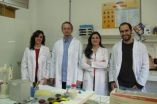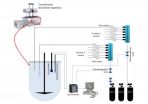(Press-News.org) WASHINGTON (March 31, 2014) — A new stent covered with biodegradable coating continues to show statistical equivalence to Japan's market leader in cumulative second-year data and subgroup analyses, according to research from the NEXT trial presented at the American College of Cardiology's 63rd Annual Scientific Session. NEXT is the largest head-to-head randomized study of these two stents – the novel biolimus-releasing model with the degradable coating (BES) and the everolimus-releasing standard with a durable polymer (EES).
Polymer coatings contain the drugs in drug-eluting stents, and slowly release agents to keep the stent clear of new lesions called intima neointima formations that lead to target lesion revascularization – a second procedure to restore blood flow to the blocked artery after a stent is in place. Drug-releasing stents have become standard treatment, but the permanent polymer that holds the helpful drug can cause late clinical problems.
First year results for 3,235 patients randomly assigned to BES (1,617 patients; 2,059 lesions) or EES (1,618 patients; 2,010 lesions) demonstrated statistically equivalent outcomes for the efficacy endpoint of target lesion revascularization and the composite safety endpoint of death from all causes and heart attack. The track record of non-inferiority continued with year-two data: BES 7.8 percent compared to EES 7.7 percent for safety endpoints; BES 6.2 percent compared to EES 6 percent for the efficacy endpoint. Landmark analysis at one year showed no difference in safety (BES 2.5 percent vs. EES 2.4 percent) or efficacy (BES 2 percent vs. EES 1.5 percent). Subgroup analysis for target lesion revascularization in patients with diabetes, insulin-treated diabetes, patients 75 years or older, hemodialysis, and multi-vessel angioplasty revealed no significant differences in cumulative incidence.
"Recent network meta-analyses suggested that drug-eluting stents with a biodegradable polymer had an excess risk for stent thrombosis or heart attack compared with second-generation everolimus stents with a durable coating," said Masahiro Natsuaki, M.D., Kyoto University Graduate School of Medicine's Cardiovascular Medicine Department. "However, we found no significant differences between the BES and EES groups. There was no apparent signal suggesting either improvement or impairment of clinical outcomes with one stent or the other."
Natsuaki cautioned that underreporting of adverse events, especially stent thrombosis, is possible because study participants were not fully monitored. But angiograms in patients with target vessel revascularization were rigorously evaluated for blood clots at an angiographic core laboratory, and "adjudication of death and heart attack events was conducted very carefully" to rule out stent thrombosis, he said.
Because the BES biodegradable polymer takes up to a year to disappear, any differences in outcome between the two stent types will be evident only after the first year. "The advantage of polymer degradation and no permanent polymer in the vessel wall could emerge with longer-term follow up," Natsuaki said. If year-three results confirm that outcomes with BES are at least equal to EES, patients with complex lesions requiring heart bypass surgery could be candidates for additional studies, he said.
INFORMATION:
The study was sponsored by Terumo Japan. Natsuaki indicated no conflict of interest.
This study will be simultaneously published online in the Journal of the American Medical Association at the time of presentation.
The ACC's Annual Scientific Session brings together cardiologists and cardiovascular specialists from around the world each year to share the newest discoveries in treatment and prevention. Follow @ACCMediaCenter and #ACC14 for the latest news from the meeting.
The American College of Cardiology is a nonprofit medical society comprised of 47,000 physicians, surgeons, nurses, physician assistants, pharmacists and practice managers. The College is dedicated to transforming cardiovascular care, improving heart health and advancing quality improvement, patient-centered care, payment innovation and professionalism. The ACC also leads the formulation of important cardiovascular health policy, standards and guidelines. It bestows credentials upon cardiovascular specialists, provides professional education, supports and disseminates cardiovascular research, and operates national registries to measure and promote quality care. For more information, visit CardioSource.org.
Biolimus still comparable to everolimus in year 2 of stent match-up
No differences seen in cumulative safety, efficacy measures
2014-03-31
ELSE PRESS RELEASES FROM THIS DATE:
Tested a drug that strengthens the analgesic effect of opioids without increasing constipation
2014-03-31
Scientists from the University of Granada have taken part, alongside the Esteve laboratory, in the development of a new drug that multiplies the analgesic effect of opioids (drugs for treating intense pain), without increasing constipation, one of the most common side-effects of these drugs, among which is morphine.
This important scientific breakthrough has been published in The Journal of Pharmacology and Experimental Therapeutics, and has been chosen as its outstanding article in the month of January. So far, the University of Granada researchers have published the ...
Researchers develop device that simulates gastro-intestinal tract
2014-03-31
A breakthrough in drug testing developed by a University of Huddersfield lecturer could lead to cheaper, more effective medicines. Dr Hamid Merchant is a member of the team that has created a device which accurately simulates the gastro-intestinal tract and how it absorbs medication. This means that the cost of clinical trials could be greatly reduced, with savings passed on to customers.
Dr Merchant has joined the University as a Senior Lecturer in Pharmaceutics. Previously a postdoctoral fellow at University College London (UCL), he has extensive research experience, ...
Certain genetic variants may identify patients at higher risk of bladder cancer recurrence
2014-03-31
While patients diagnosed with bladder cancer usually face a favorable prognosis, many experience recurrence after treatment. Because frequent, painful screenings are needed to identify recurrences, the ablility to identify patients at high risk of recurrent cancer could help to improve quality of life for all bladder cancer patients.
A new study published in BJU International, "Genetic polymorphisms modify bladder cancer recurrence and survival in a U.S. population-based prognostic study," suggests that certain inherited DNA sequences may affect a bladder cancer patient's ...
Heparin more effective than bivalirudin in patients during emergency heart procedure
2014-03-31
WASHINGTON (March 31, 2014) — In a comparison of two blood-thinning medications, heparin was associated with significantly fewer major cardiovascular events at 28 days than bivalirudin in patients receiving primary percutaneous coronary intervention after a heart attack, according to research presented at the American College of Cardiology's 63rd Annual Scientific Session.
The single-center, open label trial enrolled 1,829 patients with suspected heart attack who received a coronary angiography, an imaging test to see how blood flows through the heart. Patients were randomized ...
Anti-anxiety drugs and sleeping pills linked to risk of death
2014-03-31
Anti-anxiety drugs and sleeping pills have been linked to an increased risk of death, according to new research from the University of Warwick.
The large study, published in BMJ, shows that several anxiolytic (anti-anxiety) drugs or hypnotic drugs (sleeping pills) are associated with a doubling in the risk of mortality.
Although these findings are based on routine data and need to be interpreted cautiously, the researchers recommended that a greater understanding of their impact is essential.
Professor Scott Weich, Professor of
Psychiatry at the University of ...
Drug-eluting stents demonstrate better outcomes after 1 year than bare metal stents
2014-03-31
WASHINGTON (March 31, 2014) — Use of drug-eluting stents is associated with a lower risk of major cardiovascular events at one year compared to bare metal stents when followed by an individualized course of blood-thinning medication among patients previously thought to be uncertain candidates for drug-eluting stents due to their heightened risk of bleeding or blood clots, according to research presented at the American College of Cardiology's 63rd Annual Scientific Session.
Positive study findings for patients receiving a shorter than currently recommended course of ...
Never say never in the nano-world
2014-03-31
This news release is available in German.
Objects with sizes in the nanometer range, such as the molecular building blocks of living cells or nanotechnological devices, are continuously exposed to random collisions with surrounding molecules. In such fluctuating environments the fundamental laws of thermodynamics that govern our macroscopic world need to be rewritten. An international team of researchers from Barcelona, Zurich and Vienna found that a nanoparticle trapped with laser light temporarily violates the famous second law of thermodynamics, something that ...
New human trial shows stem cells are effective for failing hearts
2014-03-31
WASHINGTON (March 31, 2014) — Patients with severe ischemic heart disease and heart failure can benefit from a new treatment in which stem cells found in bone marrow are injected directly into the heart muscle, according to research presented at the American College of Cardiology's 63rd Annual Scientific Session.
"Our results show that this stem cell treatment is safe and it improves heart function when compared to placebo," said Anders Bruun Mathiasen, M.D., research fellow in the Cardiac Catherization Lab at Rigshospitalet University Hospital Copenhagen, and lead investigator ...
Real-world heart procedure results consistent with scientific research
2014-03-31
WASHINGTON (March 31, 2014) — The first one-year outcomes data of transcatheter heart valve replacement (TAVR) in nearly all U.S. patients undergoing this procedure shows that real-world outcomes are comparable to or slightly better than those found in clinical trials, according to registry data presented at the American College of Cardiology's 63rd Annual Scientific Session. However, specific baseline characteristics of patients undergoing TAVR are associated with differing degrees of death and survival and may be important considerations for patient counseling and shared ...
Newly discovered molecule may offer hope for immune disorders and runaway inflammation
2014-03-31
A new research discovery published in the April 2014 issue of the Journal of Leukocyte Biology may open the door to new therapies that help treat immune disorders or curb runaway inflammation. Specifically, scientists have discovered a molecule that can induce cell death (apoptosis) in a key type of immune cell (dendritic cells). With this understanding, it may be possible to develop new therapies that essentially shut down dendritic cell activity, and thereby reducing an immune reaction.
"We hope that our findings provide better understanding of immune regulation, which ...
LAST 30 PRESS RELEASES:
iPS cells from dish to freezer and back
Deep neural networks enable accurate pricing of American options under stochastic volatility
Collective risk resonance in Chinese stock sectors uncovered through higher-order network analysis
Does CPU impact systemic risk contributions of Chinese sectors? Evidence from mixed frequency methods with asymmetric tail long memory
General intelligence framework to predict virus adaptation based on a genome language model
Antibiotic resistance is ancient, ecological, and deeply connected to human activity, new review shows
Vapes, pouches, heated tobacco, shisha, cigarettes: nicotine in all forms is toxic to the heart and blood vessels
From powder to planet: University of Modena engineers forge a low-carbon future for advanced metal manufacturing
Super strain-resistant superconductors
Pre-school health programme does not improve children’s diet or physical activity, prompting call for policy changes, study finds
Autumn clock change linked to reduction in certain health conditions
AI images of doctors can exaggerate and reinforce existing stereotypes
Where medicine meets melody – how lullabies help babies and parents in intensive care
We may never be able to tell if AI becomes conscious, argues philosopher
AI video translation shows promise but humans still hold the edge
Deep ocean earthquakes drive Southern Ocean’s massive phytoplankton blooms, study finds
Without campus leftovers to pick through, the beaks of this bird changed shape during the pandemic
High-dose antibiotic does not reduce mortality in tuberculous meningitis
How many insects fly in the sky above the USA?
Could cheese protect your brain health?
Who faces more difficulty recovering from stroke?
Colliding galaxies create the brightest, fastest growing black holes at their center
New BrainHealth research reveals tradeoffs on sleep with cannabis use for chronic pain
Aging-US now on ResearchGate, enhancing visibility for authors and readers
'Molecular glue' stabilizes protein that inhibits development of non-small cell lung cancer
Mount Sinai Health System is recognized in 2025 Chime Digital Health Most Wired survey
From prey to predator: How carnivores spread beneficial fungi
Menopause symptoms may be frequent and have negative effects, according to female endurance athletes
US Congressmembers’ responses on X to mass shooting events differ along party lines
KAIST-UEL team develops “origami” airless wheel to explore lunar caves
[Press-News.org] Biolimus still comparable to everolimus in year 2 of stent match-upNo differences seen in cumulative safety, efficacy measures


